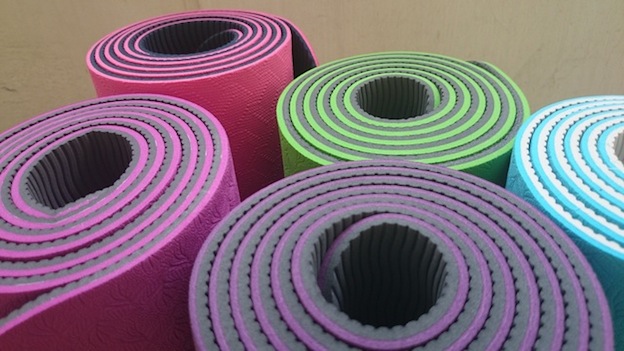SingaporeMotherhood | Pregnancy
September 2015
Prenatal Yoga: All you need to know

Are you a yoga practitioner wondering if you should continue now that you’re pregnant? Or perhaps you’ve heard that yoga is good for pregnant mothers but are not sure how to start as you’ve never tried yoga before. We’ve asked the experts for answers.
Can you do it?
According to Dr. Gordon Lim of Gordon Lim Clinic & Surgery for Women, Senior Consultant in Obstetrics & Gynaecology, prenatal yoga is definitely beneficial for expectant mothers — but not all.
He explains, “Yoga can be great in the second and third trimesters for women who have uncomplicated pregnancies. Of course, the exercises should be done with a trained instructor who is knowledgeable in yoga positions that are suitable for each stage of pregnancy. It can be challenging for a newbie to yoga or in the case of one who has been doing yoga for some time, perhaps less challenging.”
Dr. Lim also warns, “Pregnant women who have any medical condition such as heart disease, high blood pressure, overactive thyroid or pregnancy complications such as preeclampsia, placental dysfunction, placenta previa, bleeding or signs of premature labour should also avoid yoga. It is always best to check with your own gynaecologist whether yoga is suitable for you.”
How does prenatal yoga benefit you during pregnancy?
• It is an ideal way to stay in shape as it helps tone your muscles, improve balance and circulation, and keep you limber, with minimum impact on your joints.
• It also helps to prevent and reduce swelling and joint inflammation at the feet and ankles caused by decreased blood circulation and increased water retention.
• By reducing muscular tension and improving posture through stretching the muscles in the lower back and along the spine, it can help prevent and reduce lower back pain as your baby bump grows.
• It is often found to act as a natural remedy against common prenatal discomforts such as morning sickness.
• It provides emotional stress relief by helping to balance the hormones, while the breathing and relaxation exercises provide a calming effect, giving you a better overall sense of well-being.
• Taking prenatal yoga classes is also a great way to meet other expectant mothers, and form a supportive community in a positive environment. In addition to the emotional boost of knowing you are not alone, it helps motivate you to keep exercising.
• Best of all, a happy and emotionally-balanced mother means a more relaxed foetus as well, and the proper breathing techniques will help to ensure better oxygen flow to baby too.
“It is a wonderful form of exercise that improves flexibility, strengthens the muscles in preparation for the delivery, and at the same time helps to calm the mind and allay anxiety; a form of focused meditation. Yoga can also help with awareness of your anatomy and the changes that are taking place in your body. Stretching, toning, and strengthening the relevant muscles and ligaments of your back and pelvis will help prevent back problems and injuries, and prepare you for labour and delivery,” summarises Dr. Lim.
What should a prenatal yoga class have?
We asked Debra Flashenberg, Director of the Prenatal Yoga Center in New York, to find out what a well-designed prenatal yoga class should do for you. She shares that a class should help:
• Create confidence in the strength and power of your body
• Create awareness and acceptance of your changing body
• Allow you to spend time with your unborn baby
• Alleviate aches and pains
• Help you to discover movements that might be beneficial during labour
• Allow you to establish a connection and relationship with breath
• Create an open forum to discuss fears and concerns surrounding pregnancy, labour, and motherhood
• Encourage you to educate yourself on childbirth choices and allow for conscious birthing
• Offer the busy mother a space to relax and become quiet
• Help you learn conscious relaxation and surrender
• Build strength and stamina
• Raise your threshold of pain tolerance
At the same time, Debra assures us that “women can still have wonderful births without prenatal yoga” so don’t feel too bad if you can’t do prenatal yoga.
How does doing prenatal yoga help me during childbirth?
Now that your body is limber and strengthened, you are definitely more prepared for labour and delivery. The flexibility in your joints will certainly help baby along.
The deep breathing techniques will also come in handy as you now know how to stay calm when you most need to. This is important because when you are afraid and in pain, your body produces less oxytoxin, a hormone that helps the labour along. More adrenalin is produced, causing your body to tighten up.
Expecting her second child in December, 37-year-old Allison Eggers shares that she was advised by her gynecologist to try prenatal yoga during her first pregnancy.
“Having now experienced a pregnancy and birth with complications, I highly recommend prenatal yoga,” says Allison. “During labour, I remembered what the teachers had said in class and found something to focus on. Everything else in the delivery room disappeared. If I hadn’t taken prenatal yoga, I don’t know how it would have ended, probably with an epidural and a much longer labour. No one gets the delivery that they want. There are always unforeseen issues that arise but having acquired the tools to manage the difficulties, knowing that everything would work out, and I would survive, are some of the things that I learned from prenatal yoga.”
Dr. Lim agrees, “I have seen many benefits of yoga during labour and delivery of patients who attend these classes regularly. They are more mentally prepared and confident, less anxious. They are able to focus better on deep breathing which is important during the labour. I also see a tendency for those who have taken yoga to be able to withstand the pain with less analgesia and handle the discomfort of the unnatural positions that they have to assume during the delivery.”
Okay, I’m ready to start! What should I do?
• Find an instructor who is specifically trained in prenatal yoga. Be sure to inform your instructor of your pregnancy.
• Drink lots of water before, during, and after each session to stay adequately hydrated.
• Anybody should do yoga only to the best of their abilities. This is especially important for expectant mothers. Take care not to overstrain yourself.
• If you were already adept at yoga before conceiving, understand that you will have to modify your routines as your pregnancy progresses.
• Listen to what your body is saying. If you’re feeling pain or discomfort, adjust your position or ask your instructor to recommend an alternative.
• Don’t make any sudden movements. Use pillows, foam blocks, straps, and chairs to assist you if needed.
• Avoid certain yoga postures such as strenuous ones like headstands or shoulder stands, or those that affect the abdominal region, like deep forward bends, back bends, or deep twists.
• Avoid hot yoga as it can cause dangerous overheating to both mother and foetus.
Got it! When can I begin?
First things first: Get your obgyn’s blessing before you begin any physical activity when pregnant.
Yoga should generally be avoided during the first trimester due to the risk of miscarriage. If you are an experienced yoga practitioner with no history of previous miscarriages, you may proceed with caution. Ask your obgyn if you can continue. Listen to your body.
In the second trimester, be aware that joints are beginning to loosen up and that your sense of balance will be affected by your slowly expanding girth. Sink gradually into positions to avoid injury and don’t try to hold poses for too long. Avoid poses which involve lying flat on your back as this can block blood flow to the uterus.
You’ll probably need to depend more on props for stability during your third trimester. With a bigger belly, perform standing positions with your heels to the wall or use a chair for support. Losing your balance can risk injury to yourself and to baby. Keep poses slow and short – it’s vital to keep moving to maintain good blood circulation.
Ready to start? Here are our 5 favourite prenatal yoga classes in Singapore to try!
All content from this article, including images, cannot be reproduced without credits or written permission from SingaporeMotherhood.
Follow us on Facebook, Instagram, and Telegram for the latest article and promotion updates.







